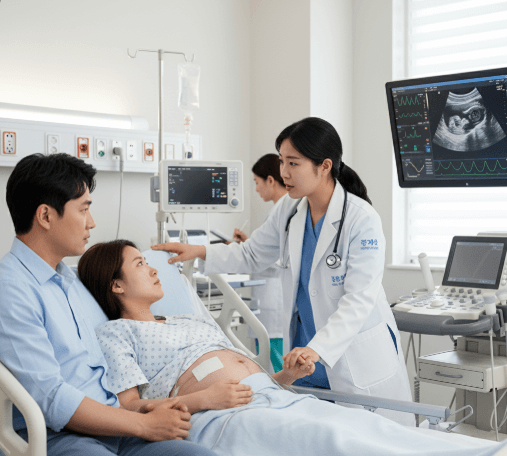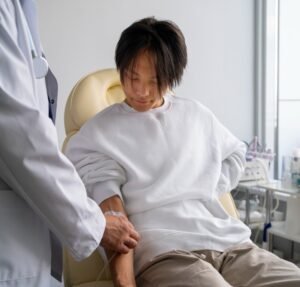What it is
A high-risk pregnancy refers to a pregnancy in which the mother, baby, or both face an increased risk of complications before, during, or after delivery. This can be due to pre-existing health conditions, age, lifestyle factors, or problems that develop during pregnancy.
👩⚕️ Common factors leading to high-risk pregnancy:
- 🩸 Maternal health conditions – diabetes, hypertension, thyroid disorders, or heart disease
- 👶 Pregnancy-related issues – preeclampsia, gestational diabetes, placenta previa, preterm labor
- 📅 Maternal age – pregnancy at age under 18 or over 35
- 🤰 Multiple pregnancy – carrying twins or triplets
- 🧬 Genetic factors – family history of complications or congenital disorders
In Korea, high-risk pregnancies are closely monitored by specialized obstetricians and often managed in advanced maternity or university hospitals with access to neonatal intensive care units (NICU).
Why it’s done
High-risk pregnancy management aims to prevent, identify, and treat complications early, ensuring the safety of both mother and baby.
🔹 Reasons why management is essential:
➡️ Reducing maternal risk – preventing conditions like stroke, organ failure, or excessive bleeding
➡️ Protecting fetal health – ensuring adequate growth, oxygen supply, and early detection of abnormalities
➡️ Timely interventions – such as early delivery, cesarean section, or specialized neonatal care
➡️ Continuous monitoring – identifying warning signs before they become life-threatening
➡️ Improved mental well-being – counseling and emotional support for mothers under stress
In Korea, doctors emphasize integrated care, where specialists (obstetricians, endocrinologists, cardiologists, neonatologists) work together.
Alternatives
While medical supervision is the cornerstone, some complementary approaches may support women with high-risk pregnancies.
🔸 Alternative or supportive options:
- 🌿 Prenatal yoga and meditation – for stress relief and improved circulation (doctor-approved only)
- 🧘 Breathing and relaxation therapies – reducing anxiety and improving oxygen flow
- 👩👩👧 Doula or midwife support – emotional guidance alongside hospital care
- 🌍 Telehealth check-ins – convenient for mothers who need frequent monitoring but live far from hospitals
⚠️ Important: These are complements, not replacements. In Korea, high-risk pregnancies are always managed within hospital-based systems for maximum safety.
Preparation
Women with high-risk pregnancies must be extra prepared for their journey.
✔️ Preparation steps include:
➡️ Collecting all medical history records – past pregnancies, surgeries, chronic conditions
➡️ Following doctor-prescribed medications strictly (e.g., insulin for diabetes, antihypertensives)
➡️ Monitoring diet and lifestyle – balanced meals, avoiding harmful substances
➡️ Keeping a daily log of symptoms – swelling, headaches, fetal movement, blood pressure
➡️ Preparing for possible hospitalization – packing essentials in advance
➡️ Learning about delivery options – vaginal birth vs. C-section for high-risk cases
In Korea, many hospitals provide prenatal education programs, where high-risk mothers receive customized instructions on diet, exercise, and warning signs.
How it’s done
High-risk pregnancy management in Korea follows a personalized plan depending on the mother’s condition.
🩺 Typical management process includes:
- ✅ Frequent check-ups – sometimes weekly or bi-weekly instead of monthly
- ✅ Advanced ultrasounds – Doppler scans, 3D/4D imaging, and fetal echocardiograms
- ✅ Specialized blood tests – monitoring thyroid, glucose, kidney, and liver functions
- ✅ Non-stress tests (NST) – checking baby’s heart rate and oxygen supply
- ✅ Hospital admissions – for close observation in critical conditions like preeclampsia
- ✅ Medications – blood thinners, insulin, or steroids to help lung development in premature babies
- ✅ Delivery planning – preparing for early induction or C-section if risks increase
💡 Unique in Korea: Many top hospitals use integrated digital systems that automatically track mother and baby health data, alerting doctors to abnormalities immediately.
Recovery
Recovery for high-risk pregnancies often extends beyond delivery, as both mother and baby may need close observation.
🟢 Steps for recovery include:
- 🏥 Postnatal monitoring – checking blood pressure, blood sugar, and healing from delivery
- 👶 Neonatal intensive care (NICU) – for premature or underweight babies
- 💊 Long-term medications – managing chronic conditions like hypertension or diabetes
- 🧘 Emotional support – counseling to manage postpartum anxiety or depression
- 🥗 Nutritional recovery – iron-rich diet, supplements, and hydration
- 📖 Follow-up visits – usually more frequent than for normal pregnancies
In Korea, many hospitals provide specialized postnatal care centers where mothers can recover while babies receive professional monitoring.
Treatment options in Korea
South Korea offers some of the most advanced high-risk pregnancy care in Asia, combining technology, expertise, and government support.
🇰🇷 Options available for high-risk pregnancy management in Korea:
➡️ University hospitals – ideal for complex cases, equipped with NICUs and multidisciplinary teams
➡️ Specialized women’s hospitals – offering tailored programs for high-risk mothers
➡️ Government-supported clinics – affordable care through the National Health Insurance Service
➡️ Private maternity centers – with luxury facilities and personalized care
🌟 Highlights of high-risk pregnancy care in Korea:
- ✅ Multidisciplinary approach: Collaboration between obstetricians, cardiologists, endocrinologists, and neonatologists
- ✅ Advanced diagnostics: High-resolution ultrasounds, genetic screening, fetal MRI
- ✅ Emergency readiness: 24/7 NICU access in top hospitals
- ✅ Government support: Financial assistance for prenatal and delivery costs
- ✅ Multilingual services: International patient departments for foreigners
✅ Final Note:
High-risk pregnancy management in Korea ensures maximum safety for mother and child through advanced technology, specialized care, and structured support systems. From preparation and monitoring to delivery and recovery, Korea’s medical infrastructure offers expectant mothers a reassuring, world-class environment to navigate even the most complex pregnancies.













